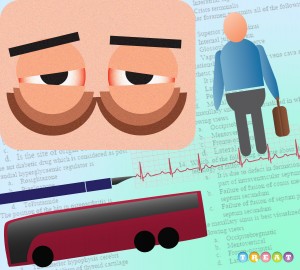Yet another season of entrance exams are coming to an end with the slog overs left and yet another season is all set to begin. With the announcement of the AIPGMEE results, the fate of 90000 odd doctors sealed as far as government seats are concerned, here are few tips and tricks on how to crack the exam.
1. In the initial 2 years since the inception of the exam, physical fitness and ability to get up early in the morning was of prime importance.  Especially on the day the application forms were out. Running and standing in a queue in a bank, obtaining a challan, receiving the form, running back to your house, logging onto the computer and getting a centre in your city was a worthwhile achievement. Of course it also was a test on whether you were smart or not as some people out of desperation finding that the centres were exhausted on day one choose another nearby city only to find out the next morning that centres in their hometown have reopened for allotment. Thankfully sanity prevailed and now your luck decides which centre you get. Furthermore, the allotment is done supposedly on a random basis by a computer which wants to empower tourism in this country. So there are high chances that your centre need not be in the same city or even the same state but in another state altogether. If you are lucky and want to experience INCREDIBLE INDIA, your centre can be in the complete opposite part of India.
Especially on the day the application forms were out. Running and standing in a queue in a bank, obtaining a challan, receiving the form, running back to your house, logging onto the computer and getting a centre in your city was a worthwhile achievement. Of course it also was a test on whether you were smart or not as some people out of desperation finding that the centres were exhausted on day one choose another nearby city only to find out the next morning that centres in their hometown have reopened for allotment. Thankfully sanity prevailed and now your luck decides which centre you get. Furthermore, the allotment is done supposedly on a random basis by a computer which wants to empower tourism in this country. So there are high chances that your centre need not be in the same city or even the same state but in another state altogether. If you are lucky and want to experience INCREDIBLE INDIA, your centre can be in the complete opposite part of India.
2. Most important trick of the lot is to make friends with a travel operator. If you are smart you would enter into the business yourself. The date on which you are allotted to write your exam and the centre you are writing in is announced barely 2 weeks prior to the examination. Definitely you would need the help of a travel operator to book transport and accommodation services at a cheap rate. Start being friendly with him and prescribing medicines for his common cold, allergies , headache, body ache from march itself so that when time comes, he would do anything for his doctor.
3. Along with joining the entrance exam coaching classes, join for a short course in statistics and probability. Training in psychology and behavioral science and understanding how another person would perceive something as difficult or easy is extremely essential. More important is to identify which question is tough and which is easy. After all the method for equating and scoring goes as follows
4. Do a heroic act for a friend who is studying engineering. Ask him to build portable UPS (uninterrupted power supply). Also ask him to build an anti-crash software. Carry both to the exam hall. Explain to the authorities when they frisk you the need for carrying both the objects. If they let you carry it, please plug it into your computer so that you don’t face these problems.
5. Start doing charitable acts from the month of March like lending your coaching notes, help out the needy and earn good karma. You need the almighty’s blessings to ensure that everything goes smooth. Pray like a man would pray on the previous day of his wedding hoping that the wedding won’t get rescheduled or cancelled the next day. After you do make it to the exam venue, pray harder that the people who are writing the exam with you don’t get their questions right.
Ladies and gentlemen, if the above sounds lame, ridiculous, downright outrageous and you would want to smash your laptop screen and stone the author, I empathize with you. This is the state of the post graduate entrance exam for higher medical education. Something that those who would have given the exams in the last 3 years can relate to. If the initial 2 years were a struggle to obtain the form and choose a centre and time of your choice, it got worse with a randomly allotted centre, venue and date. At least for the last 2 years, you knew that if you were early you could get a centre of your choice. What makes it even more ridiculous is that you don’t know when and where you are writing the exam till 2 weeks prior causing a lot of expenditure and logistical difficulties in booking travel and accommodation.
Coming to the examination, vision 2015 MCI document promised much in change of the examination pattern. It went on to give guidelines on 60% of paper being allotted for standard MCQS, and 40% to true/false, assertion/reasoning and patient management questions. Sadly what has occurred in reality is a completely different ball game. Not a single student preparing for the exam nor a single coaching centre teacher can adequately explain or justify the rank discrepancy. Not a single person from the examination conducting authority has stepped forward to explain how the scoring system is done with examples. Students are left with the complicated explanation on the website and waste time trying to decipher what it means on online forums rather than studying. Ultimately yes, the ones who study hard and consistently get the top 500-1000 rank and do well in all exams, but from 1000 rank onwards, it’s a lottery. No one can adequately explain why they got the rank they did. Is it too much to ask for transparency if the raw score, scaled score, ranks were published. Is it too much to ask for someone from the conducting agencies to come out and explain.
And not to forget about the much touted about NDA. No I am not talking about the ruling party but the NON DISCLOSURE AGREEMENT. If the questions are not being repeated from session to session, then what is the need for NDA.
Furthermore, experts of examination agencies agree that a multi session exam does well when used for analytical and logical questions and not memory based questions. Ask any PG aspirant whether the exams come close to testing reasoning power and patient management. The coaching notes where one is made to mug up speed of sperm in the uterine tract, different isoenzymes, numerous numericals, are testimony to what the exam is all about. Of course repeaters have reported an improvement in the trend of questions being asked.
The new government had a health minister who is a doctor. It is time for the scenario of entrance exams to change. One in which transparency with candidate convenience gets foremost importance. Where exam centres and venue can get booked with a click. If it’s a multisession exam, the questions have to be USMLE type clinical based scenarios rather than pure knowledge and rot based questions. That would be the better yardstick. And finally an exam in which one knows how he/ she is getting graded.Yet again The NATION WANTS TO KNOW: Is there a NEAT solution after all?













